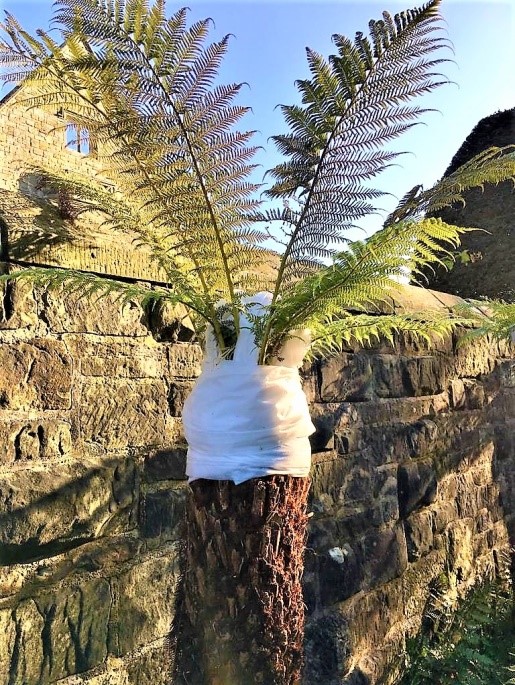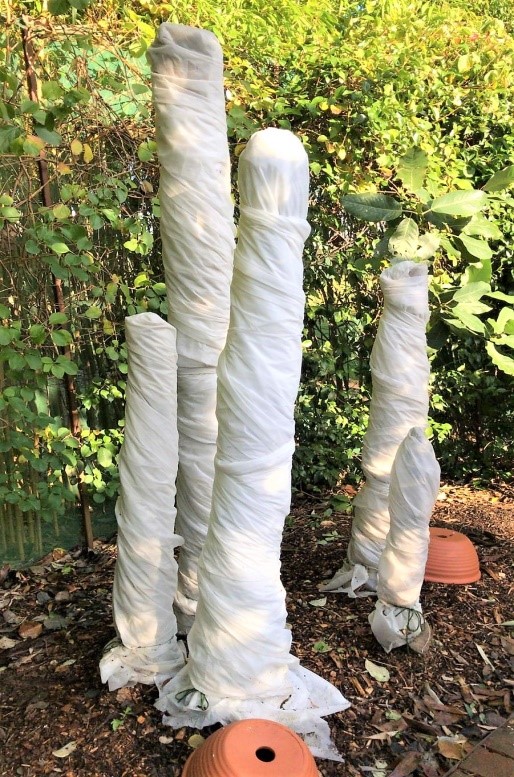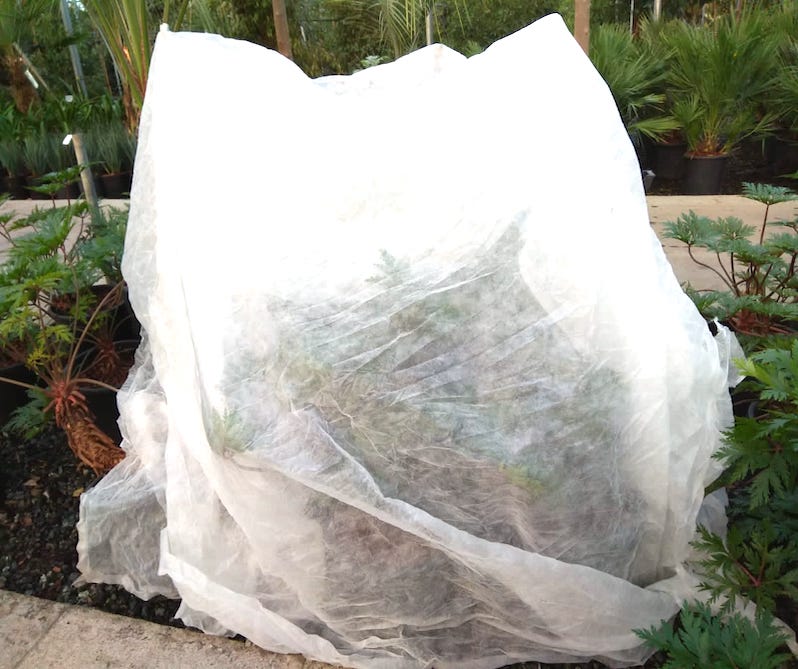
Winter protection
Top tips from our silver-tongued founder
Winter Protection
Winter wrapping: it’s a subject about which we have to admit to some agnosticism. Do we really want to look at a cylinder of chicken wire filled with dead bracken in the middle of the garden for the entire winter? Or even worse, the beloved exotics wrapped up in bubbly plastic and brown tape?
The art of wrapping exotics to get them through winters that they were never designed to get through is still in its aesthetically displeasing infancy. We’re often asked how to wrap plants for the winter as if there are established rules surrounding the subject. Sadly, there aren’t; current wisdom seems to surround edibles only, not exotics. Therefore, wrapping is mostly down to your own ingenuity, your desire to do it, and your knowledge of the plant. Having said that, here are some ideas and observations drawn from our own experience over many years.

General Tips
Wrap according to the weather forecast and not the calendar. Some winters are so mild that wrapping isn’t necessary. If the forecast predicts a very cold weather, get out there and start wrapping. You’ve got to be a bit of a meteorologist to do this, but that’s all part of the fun of becoming a gardener.
Don’t leave plants wrapped up for too long – it’ll do more harm than good. If you wrap up a Cordyline in October and unwrap it in April, it will be a dead and smelly mess. Just do it when it’s about to get cold and unwrap it as soon as the cold is over.
Use natural materials where possible because they allow some ventilation. Straw and hessian sheets are best and horticultural fleece is good, but never use plastic as it will just cause the poor thing to rot due to lack of ventilation.
Specific plant types
Dicksonia antarctica
There’s no point tying up the fronds of your Dicksonia antarctica as they always look so tatty when you unwrap them. If you follow the method used at Nymans Gardens, leave the unfurled fronds for additional winter theatre (you never know – it might snow) whilst wrapping the crown in fleece to protect the development of emerging new spring fronds. Or go the whole hog and cut the fronds off and wrap the crown and trunk in layers and layers of hessian or fleece. Short of a catastrophic winter you will be delighted to see hints of a new crown of fronds emerging when you remove the winter protection. Some people say they’ll benefit from having straw in their crown. We find the evidence for this inconclusive, but one thing that does work is to build a stack of straw bales around each plant. We actually used to do this at the nursery, but it resulted in that part of the garden looking like a farm yard for three months every year – and can you still get small straw bales anyway?

Musa basjoo
Cut the leaves off once the frost has got them and protect the trunk by whatever means you have at your disposal. Wrapping in fleece from head to toe is worth doing just to preserve the trunk. A very cold winter will cause the trunk to collapse due to the plants large cell structure and the water contained within them. Using straw bales build closely around a grove of Musa basjoo undoubtedly works.
Cordylines
Tie the leaves of the Cordyline up into a cone – if you can reach them. The old leaves will go some way towards protecting the tender growing points. Sticky tape or brown packing tape works well.
Phoenix canariensis
gaffer tape is the only thing strong enough to hold a Phoenix canariensis all together. Once it’s in a column, try wrapping it in layers of fleece and more gaffer tape. The result: an ugly, white column. You can buy rush matting quite cheaply; applying this around the fleece provides an aesthetic advantage.
Smaller, herbaceous tender exotics
Echiums, geraniums, melianthus and more
In cold gardens, Echiums (both pininiana & fastuosum), Geranium madarense, Melianthus major, Hedychiums, Cannas, and other smaller, herbaceous tender exotics require protection. You can construct a little tent over them using sticks and fleece, but it will only give minimal protection unless you introduce a heat source like an old light bulb (new light bulbs are so darned efficient they hardly give out any heat – what is the world coming to?). For Hedychiums and Cannas in particularly cold gardens, cut them down to the base and cover with a think layer of mulch. Alternatively, keep them in big pots, drag them undercover in winter, or move to Penzance, Paddington or Puerto Rico.
Please download our Winter Protection PDF to help you navigate the colder months of the year.

Further help and Guidance
We’re always happy to help with queries over the phone or by email if you can’t make it down to us. As always, feel free to get in touch if you have any questions or concerns.
